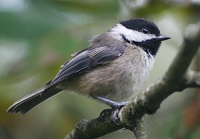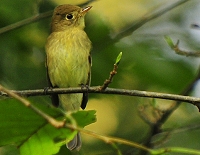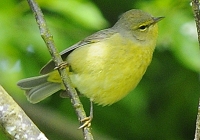Three Tips for Migration Birding
By Gord Gadsden
With fall migration well underway, here are a few tips to help in spotting the small passerine migrants (warblers, vireos and the likes) as they work their way southwards. Almost any of your favourite birding locations will generate results. If lucky, you may even encounter a 'fallout' of migrating birds. A fallout usually occurs when a flock of migrants encounter poor weather conditions which causes them to stop their migration flight suddenly. Many migrating small birds fly at night and spend the day feeding and resting so poor weather conditions overnight may result in excellent birding the following morning. Without futher ado, here are some tips:
1 - Find the Birds
 During migration, migrant birds will often move in mixed flocks containing several different species. Even during good migration movements, a portion of your favourite birding haunt may seem a little quiet. However, move around the area a little and listen. While they are not themselves migrating (outside of minor seasonal movements) chickadees are often a part of these migratory bird flocks. Happily, true to their nature, chickadees are quite loud and are more easily heard at a distance than the quieter call notes of warblers and the likes. Heading towards the sounds of chickadees will usually produce other birds. And if the chickadees are alone, it's never boring watching chickadees and their antics. You can't lose. During migration, migrant birds will often move in mixed flocks containing several different species. Even during good migration movements, a portion of your favourite birding haunt may seem a little quiet. However, move around the area a little and listen. While they are not themselves migrating (outside of minor seasonal movements) chickadees are often a part of these migratory bird flocks. Happily, true to their nature, chickadees are quite loud and are more easily heard at a distance than the quieter call notes of warblers and the likes. Heading towards the sounds of chickadees will usually produce other birds. And if the chickadees are alone, it's never boring watching chickadees and their antics. You can't lose.
2 - See the Birds
 Once you've found the birds, how can you best view the contents of the flock? A flock of birds feeding through an area will often move in the same general direction. Once you've determined their path, look ahead to see what the landscape offers. I like to find a slightly open area that allows me to stand back a little ways from the predicted arrival point of the birds. Not being too close allows me a wider field of view to see more of the area and to also save my neck. Often these birds like to get up high in the trees and it does not take long for 'warbler neck' to set in. Stepping back from the tree lowers the angle. If lucky, the area you choose to watch the flock may even have shorter trees which may bring the birds down lower.
Standing with the sun to your back will give optimum lighting to help with identification.
Now, all you have to do, if your prediction was good that is, is to watch and start identifying and enjoying the birds as they pass. You may not even have to move for minutes unless something catches your eye prompting you to move closer or the flock passes and you need to find a new vantage point. Once you've found the birds, how can you best view the contents of the flock? A flock of birds feeding through an area will often move in the same general direction. Once you've determined their path, look ahead to see what the landscape offers. I like to find a slightly open area that allows me to stand back a little ways from the predicted arrival point of the birds. Not being too close allows me a wider field of view to see more of the area and to also save my neck. Often these birds like to get up high in the trees and it does not take long for 'warbler neck' to set in. Stepping back from the tree lowers the angle. If lucky, the area you choose to watch the flock may even have shorter trees which may bring the birds down lower.
Standing with the sun to your back will give optimum lighting to help with identification.
Now, all you have to do, if your prediction was good that is, is to watch and start identifying and enjoying the birds as they pass. You may not even have to move for minutes unless something catches your eye prompting you to move closer or the flock passes and you need to find a new vantage point.
3 - Get Them in Your Binoculars
 It takes a little practice to get a little four-inch bird perched among large cottonwood tree leaves into the small field of view of your binoculars. The fact of the matter is that the little birds are hardly ever still for long either. This compounds the challenge. The worst thing to do is to try and spot a bird by scanning the trees with your binoculars. It's like searching for a lost dime in a field of tall grass through a drinking straw. Instead, from the vantage point chosen in tip #2, watch for bird movement with your eyes and then zero in on the bird with binoculars. This also takes a little practice to get your binocular on target in the small area where the bird just landed. A good piece of advice is to find a landmark near the bird you wish to get into your binoculars. It might be a large branch, a patch of dead leaves or otherwise. The key is that it is large and/or obvious enough to quickly get into your binoculars so you can then move your binoculars to where the bird is (or was). You might find yourself thinking (or mumbling to yourself if you're prone to that) "a little up and to the left of the big yellow leaf at the end of the big branch with a large fork". I think of it as a map in the landscape that helps guide your binoculars. With a bit of practice you'll find yourself able to 'map' out your path as you raise your binoculars and quickly follow it to the bird. If you don't see the bird, don't spend too much time looking through the binoculars as the bird has likely flown away to another perch. Lower the binoculars and return to scanning with your eyes. It takes a little practice to get a little four-inch bird perched among large cottonwood tree leaves into the small field of view of your binoculars. The fact of the matter is that the little birds are hardly ever still for long either. This compounds the challenge. The worst thing to do is to try and spot a bird by scanning the trees with your binoculars. It's like searching for a lost dime in a field of tall grass through a drinking straw. Instead, from the vantage point chosen in tip #2, watch for bird movement with your eyes and then zero in on the bird with binoculars. This also takes a little practice to get your binocular on target in the small area where the bird just landed. A good piece of advice is to find a landmark near the bird you wish to get into your binoculars. It might be a large branch, a patch of dead leaves or otherwise. The key is that it is large and/or obvious enough to quickly get into your binoculars so you can then move your binoculars to where the bird is (or was). You might find yourself thinking (or mumbling to yourself if you're prone to that) "a little up and to the left of the big yellow leaf at the end of the big branch with a large fork". I think of it as a map in the landscape that helps guide your binoculars. With a bit of practice you'll find yourself able to 'map' out your path as you raise your binoculars and quickly follow it to the bird. If you don't see the bird, don't spend too much time looking through the binoculars as the bird has likely flown away to another perch. Lower the binoculars and return to scanning with your eyes.
Good luck and happy birding! |